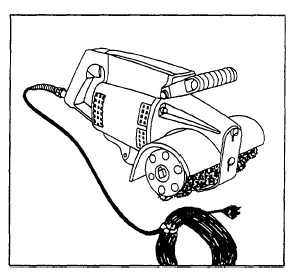struck off flush or slightly raked. Old walls softened and
disintegrated by weather action, surfaces that cannot be
cleaned thoroughly, such as painted brickwork, and all
masonry chimneys should be covered with galvanized
metal reinforcement before applying the stucco. When
masonry surfaces are not rough enough to provide good
mechanical key, one or more of the following actions
may be taken:
Old cast-in-place concrete or other masonry may
be roughened with bush hammers or other
suitable hand tools. Roughen at least 70 percent
of the surface with the hammer marks uniformly
distributed. Wash the roughened surface free of
chips and dust. Let the wall dry thoroughly.
Concrete surfaces may be roughened with an
acid wash. Use a solution of 1 part muriatic acid
to 6 parts water. Note: Add muriatic acid to the
water; never add water to the acid. First, wet
the wall so the acid will act on the surface only.
More than one application may be necessary.
After the acid treatment, wash the wall
thoroughly to remove all acid. Allow the washed
wall to dry thoroughly.
CAUTION
When your crew members are using
muriatic acid, make sure they wear
goggles, rubber gloves, and other
protective clothing and equipment.
You can quickly rough masonry surfaces using a
power-driven roughing machine (such as that
shown in figure 7-21) equipped with a cylindrical
cage fitted with a series of hardened steel cutters.
The cutters should be mounted to provide a
flailing action that results in a scored pattern.
After roughing, wash the wall clean of all chips
and dust and let it dry.
Suction is absolutely necessary to attain a proper
bond of stucco on concrete and masonry surfaces. It is
also necessary in first and second coats so the following
coats bond properly. Uniform suction also helps obtain
a uniform color. If one part of the wall draws more
moisture from the stucco than another, the finish coat
may be spotty. Obtain uniform suction by dampening
the wall evenly, but not soaking, before applying the
stucco. The same applies to the scratch and brown coats.
If the surface becomes dry in spots, dampen those areas
again to restore suction. Use a fog spray for dampening.
Figure 7-21.—Power-driven roughing machine.
When the masonry surface is not rough enough to
ensure an adequate bond for a trowel-applied scratch
coat, use the dash method. Acid-treated surfaces usually
require a dashed scratch coat. Dashing on the scratch
coat aids in getting a good bond by excluding air that
might get trapped behind a trowel-applied coat. Apply
the dash coat with a fiber brush or whisk broom, using
a strong whipping motion at right angles to the wall. A
cement gun or other machine that can apply the dash
coat with considerable force also produces a suitable
bond. Keep the dash coat damp for at least 2 days
immediately following its application and then allow it
to dry.
Protect the finish coat against exposure to sun and
wind for at least 6 days after application. During this
time, keep the stucco moist by frequent fog-spraying.
Mixing
Mixing procedures for stucco are similar to those
for plaster. Three things you need to consider before
mixing begins are the type of material you are going to
use, the backing to which the material will be applied,
and the method used to mix the material (hand or
machine). As with plaster, addition of too much of one
raw ingredient or the deletion of a raw material gives
you a bad mix. Prevent this by allowing only the
required amount of ingredients in the specified mix.
Applying
Stucco can be applied by hand or machine. Machine
application allows application of material over a large
area without joinings (joinings are a problem for
7-18


